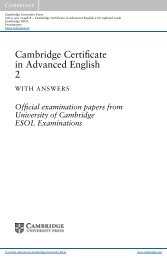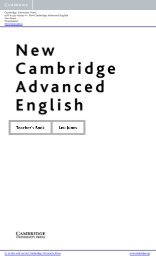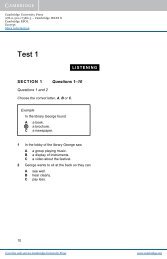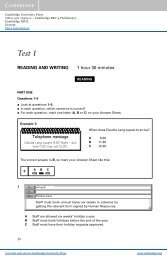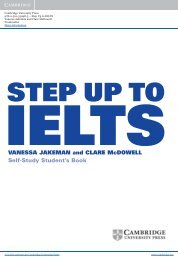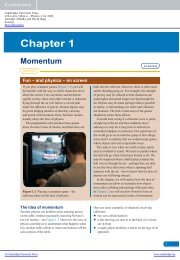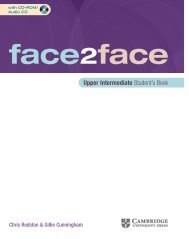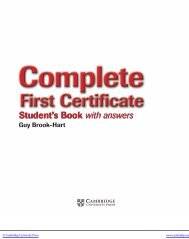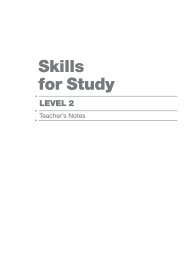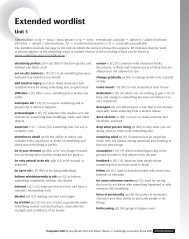1 Fashion matters - Assets - Cambridge University Press
1 Fashion matters - Assets - Cambridge University Press
1 Fashion matters - Assets - Cambridge University Press
Create successful ePaper yourself
Turn your PDF publications into a flip-book with our unique Google optimized e-Paper software.
<strong>Cambridge</strong> <strong>University</strong> <strong>Press</strong>978-0-521-70065-8 - Objective First Certificate Teacher’s Book, Second EditionAnnette Capel and Wendy SharpExcerptMore information1 <strong>Fashion</strong> <strong>matters</strong>Unit topic1.1 SB pages 8–9<strong>Fashion</strong> and describing people1.1Exam skills Speaking Paper 5 Part 2Listening Paper 4 Part 3Vocabulary Appearance and clothingPhrasal verbs1.2Grammar focus ComparisonGrammar extra Adverbs of degreeExam skills Use of English Paper 3 Part 4Workbook contents1, 2 Spelling3 Phrasal verbs4, 5, 6, 7 Reading – comprehension,superlatives, vocabulary8 Grammar – comparison9 Use of English – Part 4Throughout the unit notes, approximate timings are givenfor guidance. These relate to two lengths of lesson: SV (shortversion), corresponding to a lesson of 60–70 minutes, andLV (long version), for a lesson of around 90 minutes. Belowthese timings, there is always an indication of what to cutout of the lesson (and set for homework) for the shortversion or, conversely, what to develop in the long version.Relevant suggestions for extra activities are included in thenotes.Lesson planSpeakingListeningVocabulary30–40'15–20'20–30'SV Spend less time on topic vocabulary in 2;set 9 for homework.LV See Extension activity for 1 and script activityfor 7.1 Much of this lesson is conducted as pairwork. Explain tostudents that for the First Certificate Speaking test theywill be in pairs, with two examiners present. Referstudents to pages 6 and 7 of the Student’s Book forfurther information about this and other parts of theexamination.Allow students around five minutes for this initialdiscussion, which is an opportunity to warm up the topicand talk about something familiar. If this is a new class,the activity will also give you a chance to walk round andmake a quick assessment of their level and speakingability. It is normal at this stage of an FCE course forstudents to be nervous about speaking, so do encouragethem. Explain that by the end of the course, theirconfidence will be sky-high!Write up some useful sentence starters on the board:LikesI really like …I prefer to wear …What I absolutely love is …DislikesI hate …I wouldn’t be seen dead in …Extension activityAs an additional ice-breaker, bring in various items of clothing,both men’s and women’s; if possible, try to get hold of someobviously less fashionable items. Hold the clothes up one byone, asking what they are and eliciting student preferences.2 Ask students to describe people in other parts of theclassroom. This can be done as a guessing game, whereone student in the pair describes what a certain person iswearing and the other says who is being described. For aweaker class, start the activity off by describing someonebriefly in a couple of sentences and asking the studentswho you are describing.Students can then work in pairs or groups brainstormingtopic vocabulary. Ask them to make their lists using theheadings given. Allow enough time for this (at least fiveminutes), as a lot of the vocabulary will be needed forthe subsequent speaking task and listening material.Make sure students include the following vocabulary:Clothes: jeans, jacket, T-shirt, polo shirtFootwear: trainers, boots, sandalsJewellery: earrings, necklace, ringHeadgear: hat, baseball capMaterials: cotton, silk, polyester, suede, furHairstyle: straight, shaved, loose, tied back, wavyAppearance: casual, untidy, scruffy, fashionableRefer students to the Vocabulary spot and suggest thatheadings can be a useful way of learning topic vocabulary.10 unit 1© <strong>Cambridge</strong> <strong>University</strong> <strong>Press</strong> www.cambridge.org
<strong>Cambridge</strong> <strong>University</strong> <strong>Press</strong>978-0-521-70065-8 - Objective First Certificate Teacher’s Book, Second EditionAnnette Capel and Wendy SharpExcerptMore informationTeaching extraEvery unit in the course contains core topic vocabulary. Suggeststudents make posters for the classroom wall to help themremember some of this vocabulary. Store the posters after aunit is finished, and display them again at a later stage in thecourse (see Revision Unit notes on page 37). For Unit 1, a postercould be prepared for each of the headings given in 2, withpictures from magazines added.3 In pairs, students take it in turns to describe each of thepeople in the photographs. Allow them up to threeminutes for this and remind them to use the vocabularythey have just listed. They should not compare a pair ofphotographs yet.4 Ask students to read the Exam spot. These tinted boxescontain important information or advice about the exam.Students now make comparisons between the people ineach pair of photographs. Refer them to the examplesgiven, but encourage them to use their own ideas too.5 Elicit some of these ideas and summarise what has beendiscussed in pairs by writing up a few sentences abouteach pair of photographs. Try to use differentcomparison structures on the board. Explain that thenext lesson (1.2) will have a grammar focus, where allthese structures will be looked at and practised.6 Tell students that they are going to hear five shortrecordings, as an introduction to the matching task inPaper 4 Part 3. These will contain a variety of accents, asin the real exam.The first recording is used as an example and studentslook at photo 3b while they listen. Then suggest that theyread the transcript and think about the words in bold, tomake them aware of the need to listen carefully. Beforerepeating the recording, explain that the checking ofanswers is an essential activity at second listening in theexam.Recording scriptSpeaker 1: I’m not a suit man – even for work, I can get away withcasual stuff, though I still like my clothes to look smart. I loveshopping – my favourite place is Paul Smith in Covent Garden. Ibought a really nice woollen shirt there recently. Clothes areimportant to me, but they need to be comfortable as well asstylish.7 Ask students to listen to the four remaining extracts andmatch the correct photos to the speakers. They should dothis on their own and only compare answers when theyhave finished. Only play the recording a second time ifthey need to check their answers. (They will listen to thefour extracts again in 8.)AnswersSpeaker 2 – 2a Speaker 3 – 1a Speaker 4 – 4bSpeaker 5 – 3aRecording scriptSpeaker 2: I started working this year, so I’m able to get new clothesmore regularly than before, when I had to save up for months. I buya lot, I must confess. My mum thinks I should cut down a bit onwhat I spend, but my image is really important to me: if someonesees me in something once, I don’t like to go out in it again – well,not for a while, in any case. I like to wear bright colours and alwaysdress up when I go clubbing. I buy a big range of styles and I do tryto keep up with the latest fashions. Sometimes the things are a bitoutrageous!Speaker 3: Shopping for clothes isn’t really my scene, if you knowwhat I mean. I don’t really mind what I wear, to tell you thetruth. I’m the least fashion-conscious person I know! I suppose ifanything I favour the casual look. I’ve got two pairs of jeans and Iwear them mostly, with a T-shirt or something. I have got onefavourite top, which a girlfriend gave me. It’s red and it’s got asort of abstract design printed in navy blue on the back. She saidshe gave it to me so I would always stand out in a crowd!Speaker 4: My clothes have to be comfortable, make me feel relaxedas soon as I slip them on. I often put together outfits from stuff Ifind in street markets – they’re less expensive that way. Secondhandclothes can be real bargains, and usually, they’ve hardly beenworn! I’ll change the look of my clothes quite frequently, you know,sew in a new piece of material, swap buttons, dye something adifferent colour, just for a change. I make a lot of my own jewellerytoo.Speaker 5: My friends take far less trouble with clothes than I do –sometimes they wear the tattiest things ever! As my job involvesdealing with people, I have to make an effort to look good all thetime. I like to present a classy, sophisticated image. I go shoppingfor clothes about once a month, though if I see something bychance, I’m quite likely to go for it there and then. I think I’ve gotgood taste and I very rarely make a mistake when I buy clothes. Idid take a jacket back last week, but that was because it was badlytailored.Photocopiable recording script activity (> page 178)Students can benefit from working with recording scripts,especially at the beginning of a course. Make copies of theextracts for Speakers 2–5 and ask students to underline thekey words or phrases that gave them the correct answers.They can also use the recording scripts as an alternative wayof finding the nine phrasal verbs in 8.8 Start by checking how much students know about phrasalverbs. Explain that these are very common, particularly ininformal, spoken English. Play the recording for Speakers2–5 again and ask students to write down the phrasal verbsthey hear. Elicit these and write them up on the board.Then ask students to match them to the short definitions.(The numbers in brackets refer to the Speakers.)fashion <strong>matters</strong> 11© <strong>Cambridge</strong> <strong>University</strong> <strong>Press</strong> www.cambridge.org
<strong>Cambridge</strong> <strong>University</strong> <strong>Press</strong>978-0-521-70065-8 - Objective First Certificate Teacher’s Book, Second EditionAnnette Capel and Wendy SharpExcerptMore informationGrammar extraIn this course, these short sections cover additional smallgrammar points. They include some explanation andexamples. There is usually a short exercise to practise thepoint, which can be set for homework if necessary.Answersa a bit; muchb a great deal/a bit; much(much can be used with both comparative andsuperlative adjectives)5 Explain to students that the structure not so … as is lesscommon in everyday English nowadays. Allow them up tothree minutes to compare the cars, using the words given.Extension activityIn pairs, students can compare other ‘designer’ objects, such asiPods (now available in different colours) or chairs(comfort/elegance).6 Ask students to read the short article and identify thecomparative adverbs. If they need help, remind themthat most adverbs end in -ly. This will help students tolocate them.Answersmore commonly; less strictly; more readilyRefer them to the Grammar folder, page 198 or ask themto read this after class.The discussion on unisex clothing can be initiated byeliciting examples of popular items of unisex clothing,for example, jeans, trainers, sweatshirts.7 Explain that this exercise is an exam task from Paper 3Part 4, Key word transformations. This task type isintroduced in detail in Exam folder 1, which followsUnit 1 (pages 12–13).Make sure that students read the rubric carefully andremind them that they cannot use more than five words,including the word in bold.Note that these transformations are below the level of theexam, as a first introduction to the task format.Answers1 were cheaper/less expensive 2 the most talenteddesigners 3 as old as 4 is a lot quicker/faster than5 the least expensive of / less expensive than 6 moreelegantly dressed than 7 as straight as it 8 lesssmartly whenExam folder 1Paper 3 Part 4Key word transformationsSB pages 12–13Remind students that there is a full description of the examon pages 6–7 of the Student’s Book. Paper 3 Use of Englishhas four parts and candidates have forty-five minutes tocomplete the paper.The Exam folders can be studied by students on their ownoutside class, but notes are given below for a mini-lessonin class.1 Ask students to read the exam instructions carefully.They should then look at the example and the notesin italics.Explain that there are two marks available, relating to thetwo parts of the answer. Therefore, even if students donot produce the whole answer, they can still get a mark ifone element is accurate.2 Ask students to close their books and to discuss in pairswhat advice to give on this part of the exam. Allow thema couple of minutes to do this and suggest they makenotes.3 Now ask students to compare their notes with the advicegiven in the bullet points.Stress that the key word must not be changed in any way.Check that students understand the information aboutcontracted forms.4 This task can either be set as homework or done in class.Answers1 told Sally about a new 2 took it back 3 make an effort4 were not / weren’t as fast as 5 do not / don’t dress up6 much more easily if / when 7 far the best writer /author 8 highly priced thatexam folder 1 13© <strong>Cambridge</strong> <strong>University</strong> <strong>Press</strong> www.cambridge.org



